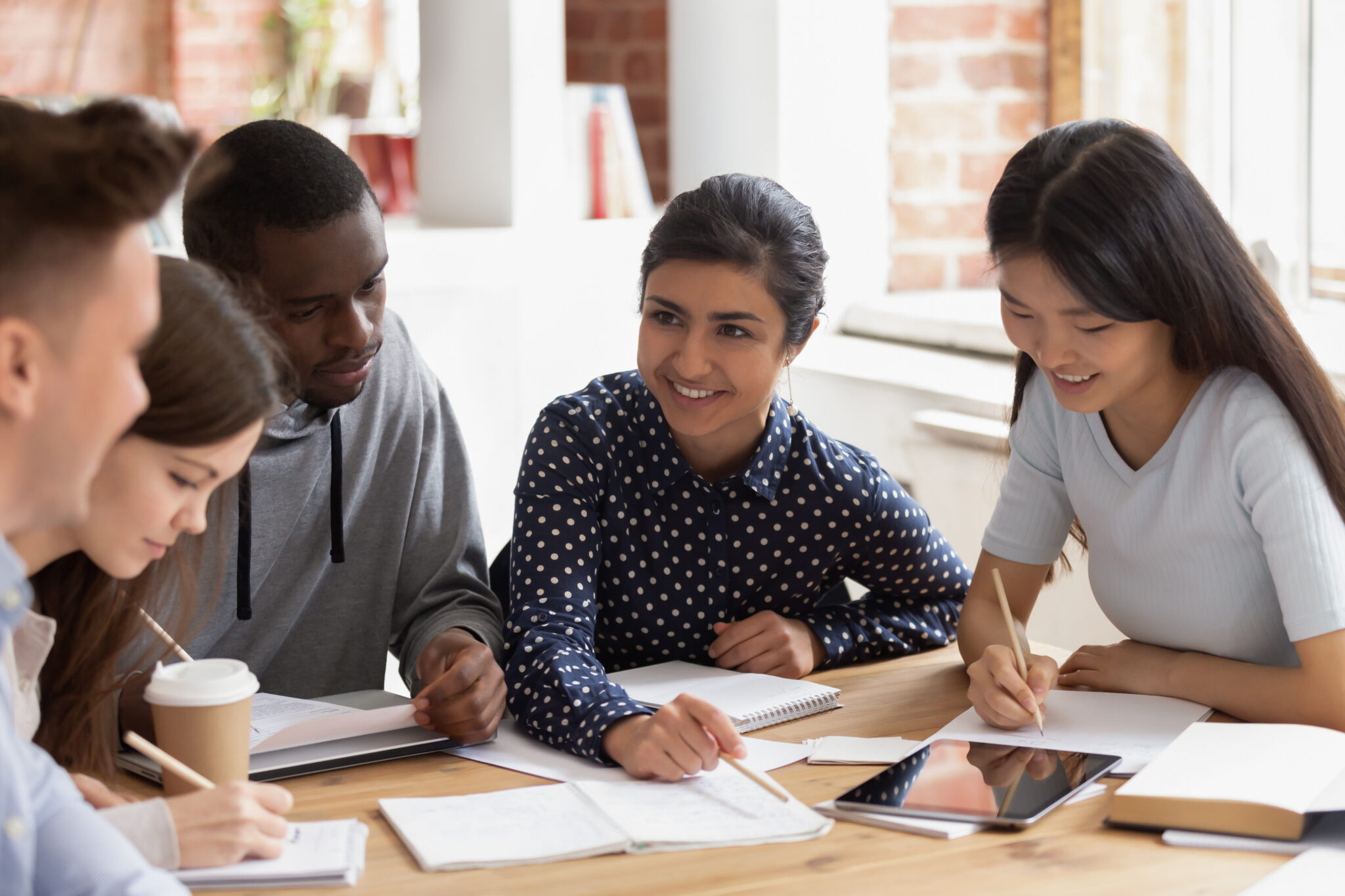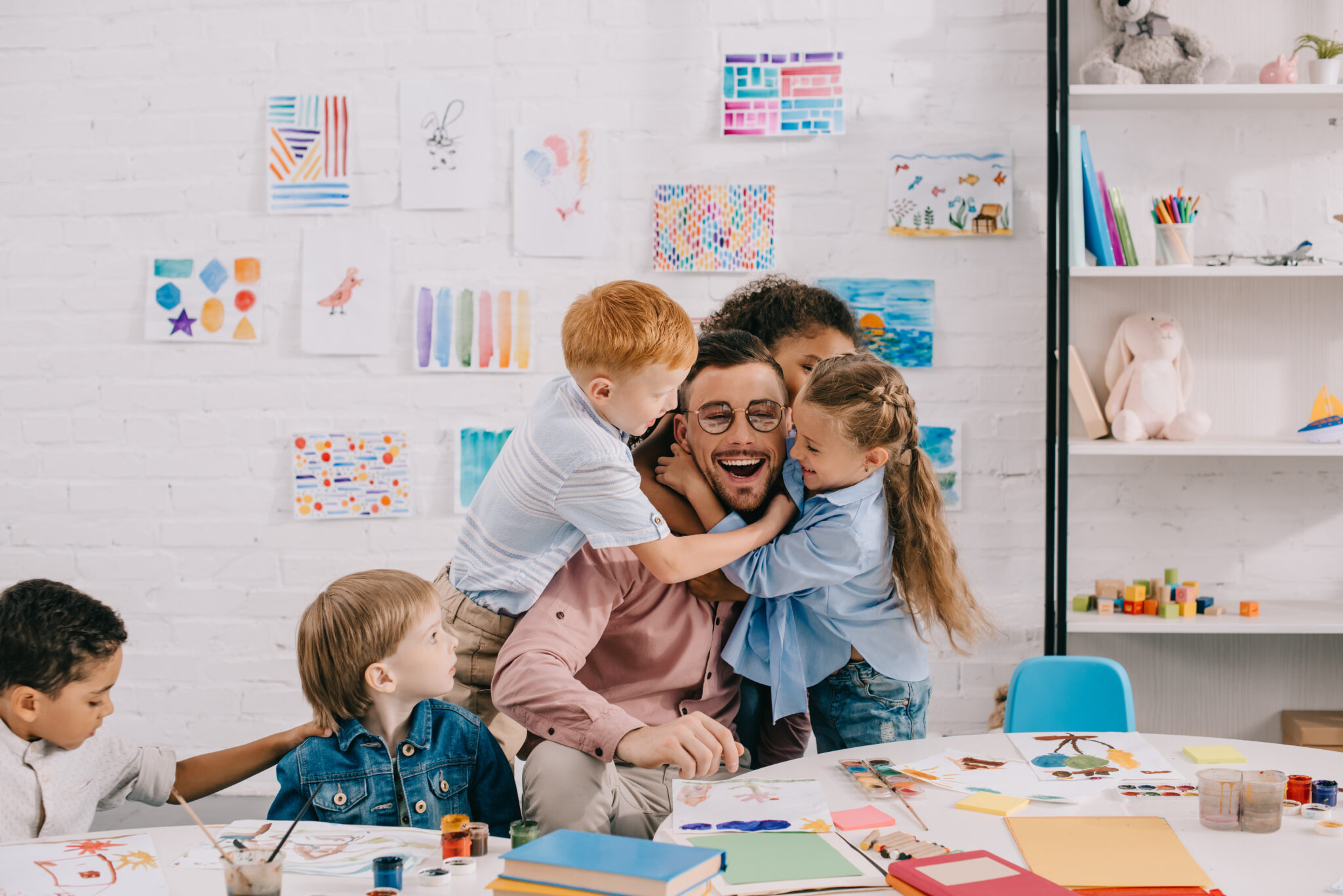Educators are always anticipating which way the pendulum will swing next. As federal and state standards change and the newest trend becomes popular, educators experience shifts in what is required and expected: what content to teach, how to teach it, which data to analyze, and ways to plan curriculum with colleagues. These changes, which can be slight or drastic, are indications of how paradigms are informing educational policy and practice. In gifted education, the schools of thought that influence the field affect not only how students are assessed and identified for gifted services, but also how educators themselves view gifted education and the services they provide. Within this article, the authors provide an overview of the varying philosophies that guide the practice of gifted education; how those beliefs affect local, state, and national policies; and the importance of this knowledge at all levels of decision making.
What Is a Paradigm?
Dai and Chen (2014) explained that “the term paradigm implies standards and norms of a field according to which we conduct business” (p. 5). Ideas about what gifted means, who is identified as gifted, how they are identified, whether identification is even necessary, and what to do once educators have determined who is (or is not) identified as gifted form the basis of each of the paradigms—depending on the answers, these ideas provide the “why,” “who,” “what,” and “how” for gifted education (Dai & Chen, 2013, 2014). Within gifted education, scholars and educators are guided by specific paradigms that shape how they approach the questions “What is giftedness?” and “How should we serve gifted students?” There are no universally accepted answers to these questions because there are multiple paradigms in play. The way scholars and educators answer those two questions represents their paradigmatic stance, which largely impacts educational policy, methods of identification, program availability, and instructional practices for gifted students.
The National Association for Gifted Children (NAGC, 2019a) emphasized that “a deeper understanding of the complex nature of giftedness” and “a multi-faceted approach to services” are both critical to meeting the needs of high-ability students in school settings and beyond (p. 1). With varying definitions of giftedness across states, it is necessary for educators and administrators to reflect upon their paradigmatic views of gifted education. Within the state of Texas, “gifted and talented student” is defined as:
a child or youth who performs at or shows the potential for performing at a remarkably high level of accomplishment when compared to others of the same age, experience, or environment and who:
- exhibits high performance capability in an intellectual, creative, or artistic area;
- possesses an unusual capacity for leadership; or
- excels in a specific academic field. (Texas Education Agency [TEA], 2019, p. 22)
The state of Texas has taken a broad, inclusive approach to how giftedness is defined; however, the definition does not tell educators how to serve students. Texas educational policy dictates that school districts follow the Texas State Plan for the Education of Gifted/Talented Students (TEA, 2019). The state plan, which has recently undergone changes (House Bill 3, 1995/2019), contains language that indicates the paradigmatic perspectives that educational leaders in the state of Texas believe are beneficial for gifted programs. Although the Texas State Plan does not provide strict blueprints for how to design a program for gifted and talented students or who to identify for services, the standards outline general expectations for districts to follow in the areas of student assessment, service design, curriculum and instruction, professional learning, and family and community involvement. These expectations reflect elements of each of the major perspectives in gifted education.
Paradigms in Gifted Education
Scholars (Dai & Chen, 2013, 2014) contend that gifted education is operating under three distinct paradigms, namely the Gifted Child Paradigm (e.g., Betts & Neihart, 1988; Hollingworth, 1926; Morelock, 1992; Silverman, 1997; The Whole Gifted Child Task Force, 2018); the Differentiation Paradigm (e.g., Borland, 2003; Peters et al., 2014; Tomlinson, 2014); and the Talent Development Paradigm (e.g., Bloom, 1985; Cross & Coleman, 2005; Dai, 2017; Renzulli, 1978; Subotnik et al., 2011; Tannenbaum, 1983; Talent Development Task Force, 2015). Dai and Chen (2013, 2014) documented the presence of these three paradigms in gifted education and some of the implications of working within each. In this article, we have similar goals; we hope to describe the beliefs that comprise the invisible infrastructure of gifted education for educators. We provide an overview of each paradigm, examine the underlying educational philosophies of each, explore the paradigmatic views represented in the NAGC (2019b) Pre-K–Grade 12 Gifted Programming Standards and the Texas State Plan for the Education of Gifted/Talented Students (TEA, 2019), and discuss current research in gifted education. A series of in-depth articles will follow in the coming months that will examine current research on the identification of students for gifted services and talent development opportunities, program design for gifted and talented students, teaching practices and pedagogy, and learner experiences through the lens of each of the paradigms.
As educators, it is necessary to understand each of the paradigms in order to interpret the assumptions underlying the policies, practices, and research, and to apply the mandates and suggestions proposed for the education of gifted and talented students. In practice, these paradigms are the lenses educators use to guide their decision making. Administrators and gifted coordinators can benefit from regular reflection on their own paradigmatic views to examine how these beliefs influence decision making (e.g., identification procedures, service models, professional development) within their district. Educators should also reflect on their paradigmatic beliefs and how these beliefs shape their instructional strategies (e.g., grouping, lesson delivery, assessment) and interactions with individual learners (e.g., feedback, performance evaluation; Missett et al., 2014). Although there is overlap between the three paradigms, there are also fundamental differences that have caused philosophical disagreements in the field (see Table 1).

The Gifted Child Paradigm
The Gifted Child Paradigm is defined by the assumption that “there exists a group of children, who, by their biological makeup, have superior learning abilities and mental qualities, worthy of a distinct classification as gifted” (Dai & Chen, 2014, pp. 55–56). This perspective dates back to some of the earliest research on giftedness from Terman (1926) and Hollingworth (1926), which changed the way the world understood “gifted” children. Previously, gifted individuals were perceived as weak and sickly, but the work of Terman and Hollingworth established the idea that gifted children are qualitatively different from their average-ability peers and require specialized education to meet their unique needs (Dai, 2010, 2018; Dai & Chen, 2014; Jolly, 2014, 2018). Over the last 100 years, those who embrace the Gifted Child Paradigm have focused on identifying individuals as gifted based on their high general intelligence. Supporters of this philosophy also point out that gifted individuals have corresponding social and emotional vulnerabilities that limit their ability to reach their full potential without educational, social, and emotional interventions (Morelock, 1992; Silverman, 1997).
The field of education and the general public sometimes perceive the perspectives and goals of the Gifted Child Paradigm as elitist (Borland, 2003), but proponents of this view might argue that their only motivation is to help children who might otherwise struggle socially and fail to reach their potential (Dai & Chen, 2014). Specifically, the goal of this framework is to identify individuals who are gifted, as defined by their above-average intelligence, and to provide a specialized educational experience that meets students’ academic and social-emotional needs while promoting self-actualization (Dai & Chen, 2014). Self-actualization is something that all parents and educators want children to experience, so they can be “involved in a cause outside their own skin, in something outside of themselves” (p. 110); experience “fully, vividly, selflessly, with full concentration and total absorption” (p. 111); use their intelligence; and actualize their potential (Maslow, 1967). Academic and social-emotional opportunities created specifically for children with varying levels of high intelligence support the well-being and optimal development of gifted children (Dai, 2010; Dai & Chen, 2013, 2014). Similarly, the stated goal for gifted and talented services that guides state policy and the Texas State Plan calls for preparing students who participate in “self-directing learning, thinking, research, and communication . . . that reflect individuality and creativity” (TEA, 2019, p. 1).
As the Gifted Child Paradigm and the associated views shaped the beginning of what gifted education is today, many of its major principles are still evident in national, state, and local policies (see Table 2). The practice of determining one’s identification based on above-average intelligence is prevalent in national policies (e.g., Every Student Succeeds Act, 2015) and the majority of state definitions regarding gifted and talented students (McClain & Pfeiffer, 2012; Rinn et al., in press). The most common way of assessing above-average intelligence for gifted identification is to compare a student’s score on a traditional intelligence test to a cut-off score that represents a certain percentile of the population. Despite associations with inequity and underidentification of students from diverse backgrounds, this method remains popular due to its historical use, its ease, and its comparably low cost of administration (Dai & Chen, 2014). In order to meet accountability in the Texas State Plan (TEA, 2019), Texas school districts are not required to use intelligence tests, but they must offer gifted identification assessment opportunities each year to all students and collect qualitative and quantitative data “for each area of giftedness served by the district” (Standard 2.17, p. 5).

Education focused on the whole child, rather than only on academics, is the foundation of the Gifted Child Paradigm (The Whole Gifted Child Task Force, 2018). In order to meet the academic, social, and emotional needs of a gifted child, programming and service designs often include curricular approaches uniquely suited to gifted students, such as acceleration, enrichment, personalized learning, and experiences with similar-ability peers (Dai & Chen, 2014; The Whole Gifted Child Task Force, 2018). To better equip educators to recognize and respond to a gifted child’s unique characteristics and learning needs, Texas requires all teachers of gifted students to participate in a 30-hour initial training and a 6-hour annual training regarding the nature and needs of gifted individuals (TEA, 2019). The Texas State Plan emphasizes appropriate instructional pacing by including guidelines for offering flexible pacing and dual/concurrent college enrollment. Additionally, the Texas State Plan offers guidance for content or grade-based acceleration as a way to provide a challenging academic environment for gifted students (TEA, 2019). Some argue that acceleration can be problematic for students who are developing asynchronously, or unevenly, and that although some students may be ready and eager for a more challenging curriculum, they may not be prepared to adjust socially to an environment with older students (Silverman, 1997). However, acceleration with social and emotional support is a viable option for students who need additional academic challenges (Colangelo et al., 2010). In addition to suggestions for personalized and interest-based learning, the state plan recommends that students be provided with opportunities for “independent investigations” and special opportunities within and out of school (TEA, 2019, Standard 3.5, p. 7). The Texas Performance Standards Project (TPSP) is a standards-based resource recommended for schools to use for rigorous, individualized enrichment projects that the typical curriculum would not otherwise cover. In alignment with the recommendation that gifted students have access to learning environments in which their social and emotional needs are supported, the state plan requires that “gifted/talented students are ensured opportunities to work together as a group, work with other students, and work independently during the school day” (TEA, 2019, Standard 3.4, p. 7). The time provided for gifted students to work with their like-minded peers allows time for students to express themselves fully and practice their social and emotional skills.
Although the Gifted Child Paradigm has been met with controversy, particularly over the ideas that giftedness is a stable trait and is identified using traditional intelligence testing, the perspectives in this framework were the catalysts for the emergence of gifted education as it exists today and are still evident in many current policies and practices.
The Differentiation Paradigm
The Differentiation Paradigm can best be defined as “providing a dynamically responsive education match for students who otherwise experience a mismatch with the curriculum normally provided” (Matthews & Foster, 2005, p. 65). Identifying giftedness as a qualitatively different, stable trait is an unnecessary distinction within this perspective, due to its focus on meeting academic needs (Borland, 2003). This paradigm is fundamentally different from the Gifted Child Paradigm, as it is less focused on a categorical assumption of giftedness (i.e., “being” gifted) and more concerned with specific, observable needs within curriculum and instruction. Thus, the Differentiation Paradigm suggests that the needs of each student should be met within the classroom setting as those educational needs arise, specifically through “continual assessment of student readiness, understanding, interest, and learning profile as means of escalating student growth” (Tomlinson, 1997, p. 161). This situational framework relies on an individualized, strength-based approach that hinges on appropriate needs-based placement within school (e.g., Response to Intervention; Coleman, 2012; Peters et al., 2014). VanTassel-Baska (2012) described differentiation as a process of “deliberate adaptation and modification of the curriculum, instructional processes, and assessments to respond to the needs of gifted learners” (p. 98). Similarly, the NAGC (2019b) Gifted Programming Standards acknowledge that educators need to utilize multiple data points (i.e., quantitative and qualitative assessments) to “develop a profile of interests, strengths and needs of each student with gifts and talents to plan appropriate interventions” (Standard 2.4.4). Moreover, learning progress should be measured using “differentiated formative assessments” and “ongoing product-based and performance based assessments” to adequately develop appropriate learning experiences based on student need (Standard 2.4.1, 2.4.2). Comparatively, the Texas State Plan describes providing opportunities for students to accelerate in their areas of strength (TEA, 2019, Standard 4.5), pursue areas of interest within selected disciplines (Standard 4.2), and provide flexible pacing “to learn at the pace and level appropriate for their abilities and skills” (Standard 4.6, p. 16).
The basic principles of differentiated practice guide educators in providing appropriate and flexible educational environments (Dai & Chen, 2014). This perspective aligns theoretically with Vygotsky’s (1978) sociocultural theory, as learning environments are influenced by social-cultural contexts, and this requires educators to assess the knowledge levels of students in order to shape academic environments to help students attain mastery (i.e., scaffolding, zone of proximal development). However, consistent implementation of differentiated instruction, including ongoing assessments to scaffold student learning, can be difficult. In the context of today’s schools, state content standards (i.e., TEKS), prescribed curriculum (i.e., district scope and sequence), standardized testing (i.e., STAAR), and administrative oversight can pressure teachers into adopting one-size-fits-all instructional approaches. Despite the challenges of implementation, scholars urge that “educationally inclusive diversity demands differentiation” (Borland, 2004, p. 121). Some administrators have redesigned their programs to support differentiated, culturally responsive initiatives in order to meet the individual needs of students (e.g., Ford et al., 2018; Mun et al., 2020). Despite best intentions, a lack of adequate support (e.g., time, resources, ongoing administrative help) can reduce the effectiveness of these programs and fuel negative perceptions of differentiation.
Those who believe gifted students should be served through differentiated approaches think that learning should be meaningful and relevant to the immediate learning needs of students (Inman & Roberts, 2018). The situational needs of all learners are in flux, which requires greater flexibility within the classroom in order for educators to actively implement differentiated practices (e.g., flexible grouping, tiered instruction, enrichment opportunities, acceleration, mastery focus). Educators and administrators must know how to use a prescriptive-based program, including how to use student assessment data to tailor instruction to the learning needs of each student (see Table 3).

This paradigmatic perspective is reflected within the Texas State Plan, as districts are required to provide differentiated learning within advanced courses with appropriate materials and to train personnel to support different learning needs of gifted students (House Bill 3, 1995/2019; TEA, 2019). Although these are noble goals, implementation can present practical challenges, as administering ongoing assessments and adequately training personnel to support those needs can be both time-consuming and costly (Crutchfield & Inman, 2020). These impracticalities are not insurmountable, but they are obstacles nonetheless, particularly in environments that lack consistency in the teaching practices of education professionals (Jolly, 2016; Kaplan, 2007). In order to implement differentiation effectively and reflect adherence to the state standards, administrators need to adequately (and actively) invest in their educators (e.g., give them time and resources).
The Talent Development Paradigm
The Talent Development Paradigm defines giftedness as a “malleable set of developing capabilities and potentialities” (Dai & Chen, 2013, p. 156) and has a long history in the field of gifted education (Talent Development Task Force, 2015). Renzulli (1978) outlined his Three-Ring Conception of Giftedness, which identified three interacting clusters of traits (above-average ability, task commitment, and creativity) that also interact with personality and the environment to result in gifted behaviors. Soon after, Tannenbaum (1983) developed a talent development model consisting of five components (general ability, special or domain-specific ability, psychosocial abilities, external support, and chance), all of which must be in place in order for giftedness to develop into performance or production during adulthood. Other models of talent development followed (e.g., Bloom, 1985; Cross & Coleman, 2005; Dai, 2017). In 2011, Subotnik et al. suggested a shift in the field of gifted education that called for domain-specific talent development as a vehicle for identifying and serving high-ability learners. The talent development framework laid out in Subotnik et al.’s megamodel has five key points: (a) ability in a talent domain matters and can be developed; (b) talent development trajectories vary by domain; (c) talent development opportunities should be provided, but also need to be accepted; (d) psychosocial skills need to be developed along with talents; and (e) the goal of talent development should be to prepare students for the possibility of eminence (p. 7). This model challenged the deeply held beliefs of some researchers and educators in gifted education. Recognizing the benefits of talent development, but not ready to discard the best practices of the Gifted Child and Differentiation Paradigms, Baum et al. (2014) presented a middle ground that made a distinction between talent development and talent focus. Talent development is defined as “encouragement and support of identified talents and abilities that are nurtured in their own right” (p. 312). Talent-focused describes approaches that involve “ongoing identification and recognition of a student’s advanced abilities as well as budding interests, along with explicit options for exploring and expressing those abilities and interests within and outside the curriculum” (p. 312). In this conception, talent development is one element of a talent-focused approach. This distinction is subtle but important.
School-based programs for advanced learners provide interest and career-related learning opportunities, but students need to willingly accept them (Subotnik et al., 2011) and should have the freedom to determine their level of involvement in them (Baum et al., 2014; Renzulli, 2012). Talent-focused approaches (e.g., the Schoolwide Enrichment Model; Renzulli, 2012) allow students to explore their interests and eventually make commitments to develop their talents (Luyckx et al., 2006), but there is no expectation that students choose one specific path to the exclusion of others. In talent development, individuals assess their abilities and preferences, choose from opportunities, and invest their time in pursuits they find personally meaningful. This often requires a trade-off between specialization in a talent domain and letting go of other areas of interest, temporarily or permanently (Worrell, 2018).
Dai (2017) contended that one major factor in talent development is characteristic adaptation, or “the spontaneous self-organization of inner resources in response to environmental opportunities and challenges” (p. 175). The choices individuals make, and the adaptation that occurs as a result, shape talent development trajectories. The Evolving Complexity Theory of Talent Development (Dai, 2017) also identifies “environmental press” and “socio-cultural mediation” (p. 176) as external influences that can help or hinder the talent development process. In other words, the learning environment is a critical factor in whether or not individuals advance in their talent development. In the NAGC (2019b) Gifted Programming Standards for Curriculum Planning and Instruction (Standard 3), talent development is explicitly listed as a student outcome. This standard focuses on the social, emotional, and psychosocial skills “necessary for achievement” in “domain(s) of talent and/or areas of interest” (Standard 3.2, p. 10). Educators are encouraged to include instructional strategies (e.g., self-evaluation, peer evaluation, teacher conferencing) that build psychosocial skills, such as “goal setting, resiliency, self-management” (Standard 3.2.1, p. 10), and to “design learning experiences for each stage of talent development” that “support high achievement and talent development” (Standard 3.2.2, p. 10). In Texas, the goal for students who participate in gifted and talented services is to develop “innovative products and performances that reflect individuality and creativity and are advanced in relation to students of similar age, experience, or environment” (TEA, 2019, p. 6) as a result of “a continuum of learning experiences” (Standard 4.3, p. 16). The Texas State Plan also emphasizes the importance of gearing the curriculum in gifted and talented courses toward the creation of products and performances that are considered “sophisticated” by “external evaluators who are knowledgeable in the field” (Standard 4.3.1, p. 16). Taken together, these standards prioritize the identification of potential or aptitude in earlier grades, the development of competence in the middle grades, and real-world engagement in professional talent domains to begin developing expertise in later grades (Krisel, 2018).
National and state standards highlight the importance of talent development opportunities, but limited access to learning opportunities and a lack of exposure to domains of possible interest may also prevent some students from culturally, linguistically, and economically diverse backgrounds from displaying the potential or advanced performance required for entry into school-based talent development programs (Horn, 2018). Although supplemental programming is recommended for accelerated talent development (NAGC, 2019b, Standard 1.4, p. 6; TEA, 2019, Standard 3.6, p. 14), students from households with limited resources may face additional barriers to out-of-school talent development opportunities (Plucker & Peters, 2016). The Talent Development Paradigm is embraced by researchers and policymakers, but practical and socially responsible application requires thoughtful implementation and consistent reflection on possible unintended consequences by gifted education professionals (Dai & Chen, 2014; see Table 4).
Why Do Paradigms Shift?
Kuhn (1970) asserted that there are several phases researchers and practitioners experience while working within a scientific field. In the beginning, those in the field strive to define key terms and develop cohesive theories. Once the norms and theoretical frameworks of the discipline are established, the field embraces a unified paradigm and works within those accepted parameters. As research and practice advance, anomalies, or instances that do not fit the accepted theories, begin to accumulate that call into question the accepted definitions and theoretical frameworks of the field. As these anomalies become harder to ignore, communities of practice must undergo a paradigm shift in order to adopt new definitions and theoretical frameworks that better fit the reality of the field (see Figure 1). In gifted education, it was once the norm to identify students for services using a single cognitive achievement test. Rigid cut-off scores excluded many students who could have benefitted from school-based gifted and talented services. As the field amassed more evidence suggesting that these identification protocols were inequitable and insufficient (e.g., nomination practices; McBee et al., 2016), gifted education moved toward the use of multiple measures and more inclusive identification practices (Lakin, 2018; McBee et al., 2014).
Toward a Unified Theory
Over time, the field of gifted education has moved from static views to more dynamic, inclusive views of giftedness. The answers to the question “what is giftedness?” shape decisions about how educators choose to serve students. Supporters of the Gifted Child Paradigm assert that giftedness is an inherent and immutable trait, those who embrace the Talent Development Paradigm insist that giftedness is revealed through actions, and individuals who subscribe to the Differentiation Paradigm refocus the goals of gifted education on current academic needs. These contrasting viewpoints can lead to discrepant views on the purpose and procedures for gifted identification, to conflicting ideas about gifted programming options, and to differing conceptions about the goals of gifted education. The three paradigms are similar in that their supporters all agree that people with gifts and talents have different needs based on their individual strengths and interests, that ability must continually be developed through domain-specific skills and psychosocial skills, and that environments (e.g., classrooms, home) play a role in providing opportunities or obstacles to continued growth (Dai & Chen, 2014).
Dai and Chen (2014) proposed a unified theory of gifted education that supports the academic and socioemotional needs of gifted learners, as well as the development of potential in a talent domain. This unified theory prioritizes the individual student and allows learners to select developmental pathways that fit with their personal aspirations. The unification of the talent development and differentiation paradigms hinges on addressing “equity concerns and the match between identification and educational provision/intervention” (Dai & Chen, 2014, p. 223). In talent development and differentiated learning contexts, the social, emotional, and psychosocial skills espoused by supporters of the Gifted Child Paradigm are still critical elements in maintaining student engagement, self-concept, and motivation to learn.
Educators need a unified vision of giftedness that is centered on inclusive and socially responsible practice that is academically, socially, and emotionally appropriate for the developmental needs of students at each level. Educators need creative solutions (e.g., diagnostic assessments, independent study courses) to tailor flexible learning opportunities and curricular paths that account for individual student differences and interests (Dai & Chen, 2014; Tomlinson, 2014). Students can benefit from curricular choices that allow them to “internalize and transform knowledge and skills” to build expertise and enhance creative process skills within domains of interest (Dai & Chen, 2014, p. 227; see also Subotnik et al., 2011). However, the flexibility granted to local education agencies in Texas presents opportunities for school districts to design innovative solutions for equitable identification, the delivery of high-quality programming in multiple domains, practical and purposeful professional development, and the preparation of high-ability students for future education and career opportunities.
Conclusion
It is a mistake to reduce the complex issues associated with gifted education to broad, sweeping statements that cannot be universally applied. Renzulli (2012) referenced Leonardo da Vinci’s statement that “he who loves practice without theory is like a sailor who boards a ship without a rudder and compass, and never knows where he may land” (p. 150) in order to remind stakeholders in gifted education that balance is vital. As practitioners and researchers who serve students from diverse populations in varied educational settings, we owe it to ourselves and to the students we serve to understand all three paradigms operating in gifted education. It is critical to account for individual differences when determining the best course of action for working with high-ability students. So, as gifted education professionals, we need more than one lens through which to view the needs of academically advanced learners and need to craft individual education plans for gifted students in today’s schools with today’s practical, social, and cultural pressures.
References
Baum, S. M., Schader, R. M., & Hébert, T. P. (2014). Through a different lens: Reflecting on a strengths-based, talent-focused approach for twice-exceptional learners. Gifted Child Quarterly, 58(4), 311–327. https://doi.org/10.1177/0016986214547632
Betts, G. T., & Neihart, M. (1988). Profiles of the gifted and talented. Gifted Child Quarterly, 32(2), 248–253. https://doi.org/10.1177/001698628803200202
Bloom, B. S. (Ed.). (1985). Developing talent in young people. Ballantine Books.
Borland, J. H. (2003). The death of giftedness: Gifted education without gifted children. In J. H. Borland (Ed.), Rethinking gifted education (pp. 105–125). Teachers College Press.
Borland, J. H. (2004). Issues and practices in the identification and education of gifted students from under-represented groups (RM04186). University of Connecticut, The National Research Center on the Gifted and Talented. https://nrcgt.uconn.edu/wp-content/uploads/sites/953/2015/04/rm04186.pdf
Colangelo, N., Assouline, S. G., Marron, M. A., Castellano, J. A., Clinkenbeard, P. R., Rogers, K., Calvert, E., Malek, R., & Smith, D. (2010). Guidelines for developing an academic acceleration policy. National work group on acceleration. Journal of Advanced Academics, 21(2), 180–203. https://doi.org/10.1177/1932202X1002100202
Coleman, M. R. (2012). Response to intervention (RtI) approaches to identification practices within gifted education. In C. M. Callahan & H. L. Hertberg-Davis (Eds.), Fundamentals of gifted education: Considering multiple perspectives (pp. 152–158). Routledge.
Cross, T. L., & Coleman, L. J. (2005). School-based conception of giftedness. In R. J. Sternberg & J. E. Davidson (Eds.), Conceptions of giftedness (2nd ed., pp. 52–63). Cambridge University Press.
Crutchfield, K., & Inman, T. F. (2020). Teacher preparation and gifted education. In J. A. Plucker & C. M. Callahan (Eds.), Critical issues and practices in gifted education: A survey of current research on giftedness and talent development (3rd ed., pp. 471–484). Prufrock Press.
Dai, D. Y. (2010). The nature and nurture of giftedness: A new framework for understanding gifted education. Teachers College Press.
Dai, D. Y. (2017). Envisioning a new foundation for gifted education: Evolving Complexity Theory (ECT) of talent development. Gifted Child Quarterly, 61(3), 172–182. https://doi.org/10.1177/0016986217701837
Dai, D. Y. (2018). A history of giftedness: A century of quest for identity. In S. I. Pfeiffer, APA handbook of giftedness and talent (pp. 3–23). American Psychological Association.
Dai, D. Y., & Chen, F. (2013). Three paradigms of gifted education: In search of conceptual clarity in research and practice. Gifted Child Quarterly, 57(3), 151–168. https://doi.org/10.1177/0016986213490020
Dai, D. Y., & Chen, F. (2014). Paradigms of gifted education: A guide to theory-based, practice-focused research. Prufrock Press.
Every Student Succeeds Act, 20 U.S.C. § 6301 (2015). https://congress.gov/114/plaws/publ95/PLAW-114publ95.pdf
Ford, D. Y., Dickson, K. T., Davis, J. L., Scott, M. T., & Grantham, T. C. (2018). A culturally responsive equity-based bill of rights for gifted students of color. Gifted Child Today, 41(3), 125–129. https://doi.org/10.1177/1076217518769698
Hollingworth, L. S. (1926). Gifted children: Their nature and nurture. Macmillan.
Horn, C. V. (2018). Serving low-income and underrepresented students in a talent development framework. In P. Olszewski-Kubilius, R. F. Subotnik, & F. C. Worrell (Eds.), Talent development as a framework for gifted education: Implications for best practices and applications in schools (pp. 129–152). Prufrock Press.
House Bill 3, Tx. Stat. § 29.122 (1995 & rev. 2019). https://capitol.texas.gov/tlodocs/86R/billtext/html/HB00003F.HTM
Inman, T. F., & Roberts, J. L. (2018). Differentiation. In J. L. Roberts, T. F. Inman, & J. H. Robins (Eds.), Introduction to gifted education (pp. 253–276). Prufrock Press.
Jolly, J. L. (2014). Great investigators. In A. Robinson & J. L. Jolly (Eds.), A century of contributions to gifted education: Illuminating lives (pp. 59–63). Routledge.
Jolly, J. L. (2016). Differentiated curriculum: Learning from the past and exploring the future. In T. Kettler (Ed.), Modern curriculum for gifted and advanced academic students (pp. 23–35). Prufrock Press.
Jolly, J. L. (2018). A history of American gifted education. Routledge.
Kaplan, S. N. (2007). Differentiation: Asset or liability for gifted education? Gifted Child Today, 30(3), 23–24. https://doi.org/10.4219/gct-2007-43
Krisel, S. C. (2018). Programming for talent development inside school. In P. Olszewski-Kubilius, R. F. Subotnik, & F. C. Worrell (Eds.), Talent development as a framework for gifted education: Implications for best practices and applications in schools (pp. 43–62). Prufrock Press.
Kuhn, T. S. (1970). The structure of scientific revolutions (3rd ed.). University of Chicago Press.
Lakin, J. M. (2018). Making the cut in gifted selection: Score combination rules and their impact on program diversity. Gifted Child Quarterly, 62(2), 210–219. https://doi.org/10.1177/0016986217752099
Luyckx, K., Goossens, L., Soenens, B., & Beyers, W. (2006). Unpacking commitment and exploration: Preliminary validation of an integrative model of late adolescent identity formation. Journal of Adolescence, 29(3), 361–378. https://doi.org/10.1016/j.adolescence.2005.03.008
Maslow, A. H. (1967, May 22–28). Self-actualization and beyond [Conference session]. Conference on the training of counselors of adults, Chatham, MA, United States. https://files.eric.ed.gov/fulltext/ED012056.pdf
Matthews, D. J., & Foster, J. F. (2005) Mystery to mastery: Shifting paradigms in gifted education. Roeper Review, 28(2), 64–69. https://doi.org/10.1080/02783190609554340
McBee, M. T., Peters, S. J., & Miller, E. M. (2016). The impact of the nomination stage on gifted program identification: A comprehensive psychometric analysis. Gifted Child Quarterly, 60(4), 258–278. https://doi.org/10.1177/0016986216656256
McBee, M. T., Peters, S. J., & Waterman, C. (2014). Combining scores in multi-criteria assessment systems: The impact of the combination rule. Gifted Child Quarterly, 58(1), 69–89. https://doi.org/10.1177/0016986213513794
McClain, M.-C., & Pfeiffer, S. (2012). Identification of gifted students in the United States today: A look at state definitions, policies, and practices. Journal of Applied School Psychology, 28(1), 59–88. https://doi.org/10.1080/15377903.2012.643757
Missett, T. C., Brunner, M. M., Callahan, C. M., Moon, T. R., & Azano, A. P. (2014). Exploring teacher beliefs and use of acceleration, ability grouping, and formative assessment. Journal for the Education of the Gifted, 37(3), 245–268. https://doi.org/10.1177/0162353214541326
Morelock, M. J. (1992). Giftedness: The view from within. Understanding Our Gifted, 4(3), 1, 11–15.
Mun, R. U., Ezzani, M., & Lee, L. E. (2020). Culturally relevant leadership in gifted education: A systematic review. Journal for the Education of the Gifted, 43(2), 108–142 https://doi.org/10.1177/0162353220912009
National Association for Gifted Children. (2019a). A definition of giftedness that guides best practice. https://www.nagc.org/sites/default/files/Position%20Statement/Definition%20of%20Giftedness%20%282019%29.pdf
National Association for Gifted Children. (2019b). 2019 Pre-K–Grade 12 Gifted Programming Standards. http://www.nagc.org/sites/default/files/standards/Intro%202019%20Programming%20Standards.pdf
Peters, S. J., Matthews, M. S., McBee, M. T., & McCoach, D. B. (2014). Beyond gifted education: Designing and implementing advanced academic programs. Prufrock Press.
Plucker, J. A., & Peters, S. J. (2016). Excellence gaps in education: Expanding opportunities for talented students. Harvard Education Press.
Renzulli, J. S. (1978). What makes giftedness? Reexamining a definition. Phi Delta Kappan, 60(3), 180–184.
Renzulli, J. S. (2012). Reexamining the role of gifted education and talent development for the 21st century: A four-part theoretical approach. Gifted Child Quarterly, 56(3), 150–159. https://doi.org/10.1177/0016986212444901
Rinn, A. N., Mun, R. U., & Hodges, J. (in press). 2018–2019 state of the states in gifted education. National Association of Gifted Children and the Council of State Directors of Programs for the Gifted.
Silverman, L. K. (1997). The construct of asynchronous development. Peabody Journal of Education, 72(3), 36–58. https://doi.org/10.1080/0161956X.19979681865
Subotnik, R. F., Olszewski-Kubilius, R., & Worrell, F. C. (2011). Rethinking giftedness and gifted education: A proposed direction forward based on psychological science. Psychological Science in the Public Interest, 12(1), 3–54. https://doi.org/10.1177/1529100611418056
Talent Development Task Force. (2015). Talent development task force report to the board of directors. National Association for Gifted Children. https://www.nagc.org/sites/default/files/Governance/TalentDevelopmentTFReport_11%2003%2015_FINAL.pdf
Tannenbaum, A. J. (1983). Gifted children: Psychological and educational perspectives. Macmillan.
Terman, L. M. (Ed.) (1926). Genetic studies of genius: Mental and physical traits of a thousand gifted children (Vol. 1, 2nd ed.). Stanford University Press.
Texas Education Agency. (2019). Texas state plan for the education of gifted/talented students. https://tea.texas.gov/Academics/Special_Student_Populations/Gifted_and_Talented_Education/Gifted_Talented_Education
Tomlinson, C. A. (1997). Good teaching for one and all: Does gifted education have an instructional identity. Journal for the Education of the Gifted, 20(2), 155–174. https://doi.org/10.1177/016235329602000201
Tomlinson, C. A. (2014). The differentiated classroom: Responding to the needs of all learners (2nd ed.). Pearson.
VanTassel-Baska, J. (2012). The curriculum planning and instruction standard in gifted education: From idea to reality. In S. K. Johnsen (Ed.), NAGC Pre-K–Grade 12 gifted education programming standards: A guide to planning and implementing high-quality services (pp. 97–115). Prufrock Press.
Vygotsky, L. S. (1978). Mind in society: The development of higher psychological processes. Harvard University Press.
The Whole Gifted Child Task Force. (2018). The whole gifted child task force report to the board of directors. National Association for Gifted Children. https://www.nagc.org/sites/default/files/key%20reports/4.1%20WGC%20Task%20Force%20Report.pdf
Worrell, F. C. (2018). Motivation: A critical lever for talent development. In P. Olszewski-Kubilius, R. F. Subotnik, & F. C. Worrell (Eds.), Talent development as a framework for gifted education: Implications for best practices and applications in schools (pp. 253–279). Prufrock Press.
Melanie S. Meyer has been a classroom teacher in Texas for over 20 years, with experience in gifted and advanced academics settings. She is a doctoral candidate in Educational Psychology at the University of North Texas focusing on gifted and talented education. Her research interests include college choice considerations for gifted and talented students, military-connected gifted students, leadership talent development, qualitative and mixed research methodology, and college, career, and military readiness (CCMR) policy and application.
Lindsay Ellis Lee is a doctoral candidate in the Department of Educational Psychology at the University of North Texas with a concentration in gifted and talented education. Her research interests include the efficacy of gifted identification and programming, creativity, and psychosocial development of talented students. Additionally, her experience as an advanced placement teacher and instructional leader has fueled her interest in systemic factors that impact advanced learning design within schools.
Kacey Crutchfield, M.S., is a doctoral student at the University of North Texas, where she is studying Educational Psychology with a concentration in Gifted and Talented Education. Her experience as a junior high teacher and professional learning committee leader continues to influence her research interests. Her work focuses on the preparation, education, and beliefs of teachers of advanced students, academically advanced students’ psychosocial development, and the intersection between teachers’ and students’ experiences.
Dr. Meredith Miller Austin’s professional experience in gifted education is roots in Aldine and Pearland ISDs. Currently, she is the Coordinator of Gifted & Talented Education in Humble ISD and serves on the TEA Commissioner’s Advisory Council on the Education of Gifted/ Talented Students. Dr. Austin received her doctorate in education from the University of St. Thomas in Houston, where she researched leaders’ attitudes towards gifted education.
Leah Murphy has taught in both Oklahoma and Texas over her 7 years as a classroom teacher. She completed her Master’s degree in 2017 and is pursuing a Ph.D. in Educational Psychology with a concentration in gifted and talented at the University of North Texas. Her research interests pertain to equitable early childhood education opportunities and the effects on later identification as gifted and talented as well as acceleration practices.
Jessica Ottwein is a doctoral student at the University of North Texas where she studies educational psychology and gifted and talented education. Her research interests center on furthering equitable access to advanced learning opportunities for students from traditionally underrepresented populations. She is particularly interested in intersectionality and its role in the development of academic self-beliefs, motivation, and career aspirations.
Anne N. Rinn, PhD is a professor of Educational Psychology at the University of North Texas, where she also serves as the director of the Office for Giftedness, Talent Development, and Creativity. She is author of Social, Emotional, and Psychosocial Development of Gifted and Talented Individuals (Rinn, 2020) and co-editor of From Giftedness to Gifted Education: Reflecting Theory in Practice (Plucker et al., 2017). She is currently co-editor of the Journal of Advanced Academics.

